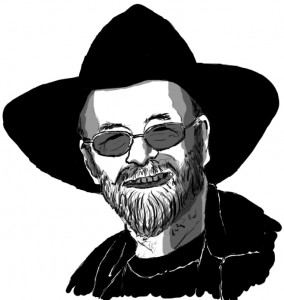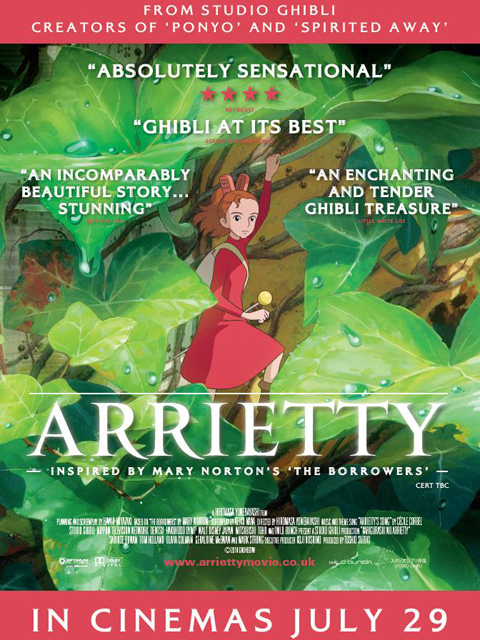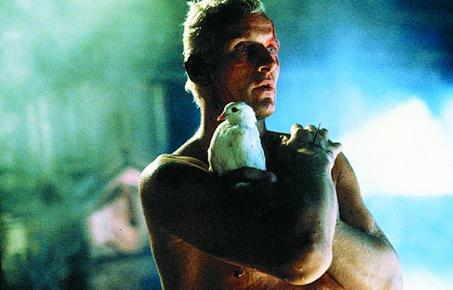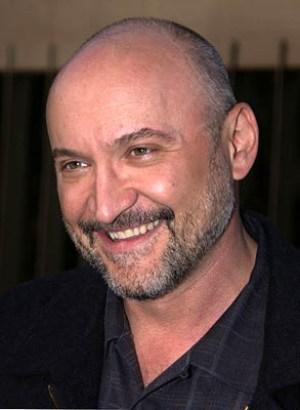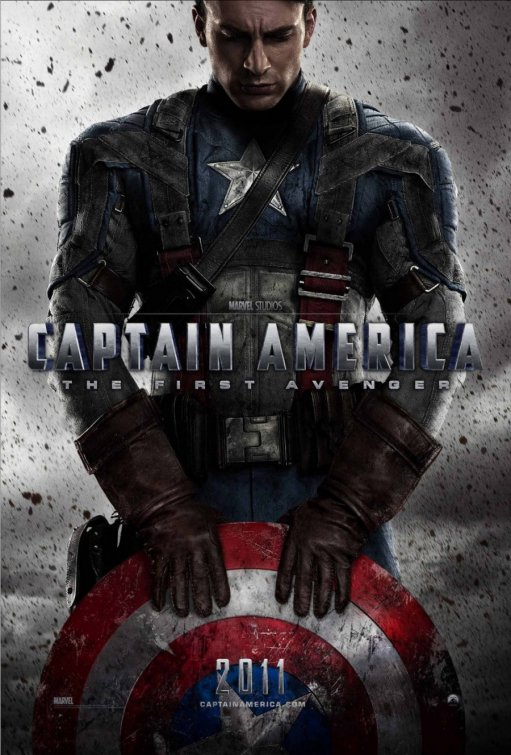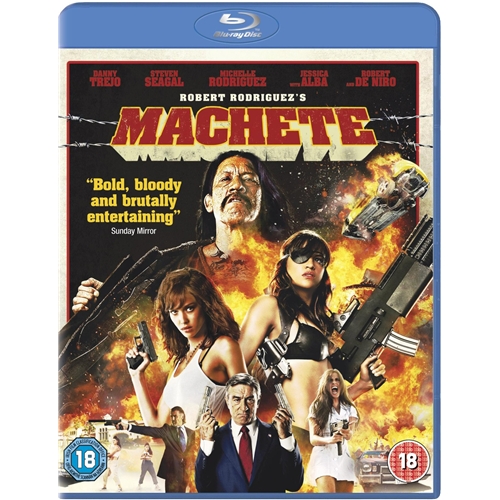Terry Practhett portrait by Darren McNaney, freelance illustrator, animator & digital effects artist.
Geekzine Editor Andy Jamieson interviewed Sir Terry Pratchett by phone in September 2010, on the eve of the promotional tour for ‘I Shall Wear Midnight’:
This has to go down as probably one of the happiest, most nerve-wracking moments of my life, interviewing one of my literary heroes. I remember setting up for the interview, as the clock ticked down to the time when I was expecting a phone call from Sir Terry’s agent, making sure my baby daughter was fed & watered and not likely to throw a wobbly or fill her nappy. With her happily entertained, I could at least focus on the job in hand. And it went better than I could have expected. I was originally instructed by email that I would have a limited time talking to Sir Terry so I deliberately structured my questions: a set that I thought it essential to ask, pertaining to his latest book, then I drafted a set of questions that, if there were time, it would be great to ask, and then I came up with a third set consisting of proper geeky-fanboy questions that I would be flippin’ lucky to get to ask. I got to ask all three sets of questions and the interview couldn’t have gone better. Below is the first part of the interview, as featured in issue 7 of the Edinburgh Geekzine, released earlier this year. Enjoy.
Andy
ps -I’d like to thank Clare Hall-Craggs at Doubleday for making it happen.
Andy Jamieson: I Shall Wear Midnight is the fourth book to feature Tiffany Aching. What is it you like about her as a character?
Terry Pratchett: Because I could make her grow, most importantly. It’s very beguiling to have a character and never ever change them but Tiffany starts off as a little girl who doesn’t know very much and ends up, more or less, as a woman, and a tough one as well, who has to do an awful lot of difficult and dangerous things.
AJ: Tiffany undergoes her own kind of Salem-esque witchhunt in your new book.
TP: You could certainly say that was one of the sources.
AJ: Was it an enjoyable challenge turning the inhabitants of the Chalk against Tiffany?
TP: It’s a little comment about how the way people feel can be changed in bad ways, for example, about how rumours can spread and, even if the rumours are untrue, nevertheless, we know that there is no smoke without fire. And so the whole nastiness wretches up, until someone throws a stone at an old woman because she has no teeth and mutters. As a metaphor that kind of thing can happen very easily today.
AJ: Onto the Nac Mac Feegles, who I see as unofficial Discworld ambassadors for the Jacobite-era Highlands…
TP: Ha! I suppose so. For the first Tiffany book, The Wee Free Men, we started the signing tour in Scotland, on the basis that if I survived that it would be a successful tour! In fact everywhere we went in Scotland people seemed to like the Nac Mac Feegle, and we were greeted with pipes and such like. Anyone who reads the Tiffany books knows that the Nac Mac Feegle are kind of a gentle parody of Scotland. Take, for example, Billy Connolly and Rab C. Nesbitt. Whilst people laugh because their performances are extravagant parodies, they are based on the kernel facts. Back to the Feegle, as the Tiffany series moves on, they become, shall we say, more real.
AJ: The clan structure, for example, is intriguing.
TP: Right, yeah. Well, I can’t give too much away in the book, but when the Nac Mac Feegle want to get serious, they can get very serious indeed.
AJ: Moving into the main Discworld series, the next two scheduled books are Snuff (featuring Sam Vimes) and Raising Taxes (the third Moist von Lipwig book). How far along are these books and what can fans expect?
TP: Raising Taxes is one that is hanging in the air. Snuff, which isn’t quite as scary as it sounds – it’s about the Tobacco industry – is about finished.
AJ: Snuff sees the return of lovable cop, Sam Vimes.
TP: Yes, and he’s by himself for the most part in this one. He’s a copper out of his jurisdiction, which always makes for fun!
AJ: Are there any more plans for Discworld graphic novels and is it a medium that you like?
TP: Well, Neil Gaiman famously started out in graphic novels, and he said that the trouble with the medium is that they’re not exactly a book and they’re not exactly a film. They have certain drawbacks. I don’t think there is anything planned in regards to future Disworld graphic novels. Quite frankly, it’s a struggle to get all the humour in. There isn’t room for all the fine detail that works in the Discworld novels. For example, it’s the occasional small sentence here and there, or a particular line at the end of gag, or whatever it is, that gladly does the job, and you can’t redo that in a graphic novel.
AJ: Also out is the dvd/blu-ray of Going Postal, the third of Sky’s Discworld adaptations (after Hogfather and Colour Of Magic). Are there any further adaptations in the works?
TP: There is another one being planned. If I say that it involves football that might give you a clue which one it is, although I couldn’t possibly say exactly what it is called…
AJ: Out of all your books, are there any in particular that you would like to see filmed, or not filmed?
TP: I really enjoyed writing Monstrous Regiment, because I had a lot of fun doing the research, and it’s one of the books that wrote itself very easily. Because it’s about something quite accessible like the Peninsula War, I think it‘s accessible to people who don’t normally read fantasy. In the same way, for example, that Unseen Academicals, though it has wizards and so forth in it, is about football. And not just about how football is played but how it relates to the community and so on. Social history, almost. I like doing that kind of stuff. And I loved doing the Dwarf fashion show, which is a first I think!
AJ: The Carpet People is still my favourite of all your books. Have you at any time considered doing a sequel to it?
TP: I did once, a long time ago. But I think the answer is: so many books, so little time. And it was good as it was. Things that I would have put in the sequel have eventually appeared in the Discworld in other guises. In terms of getting things done, I was surprised at one point, whilst writing Snuff, that I was producing two thousand words a day, which is quite fast. I’ve not been writing that quickly for a long time.
AJ: Have you and Neil Gaiman ever talked about working together again?
TP: Well, we kind of did. You see, when we finished Good Omens we were all hot for doing a sequel, or so we thought. And both of us were working on things that could go into this sequel, and then I think one day one of us said “You know, I’m not certain we have to do a sequel,” and it turned out that neither of us really wanted to do a sequel but we both thought that the other guy did so we let it play along. I think the world is better served with us both doing our separate thing than the two of us doing a joint thing. Also, it’s down to schedules. Back in those days Neil Gaiman was hardly the Neil Gaiman of today and I was barely Terry Pratchett, and nobody cared, if you see what I mean. And now both of us live in a world where we are in constant demand for a number of reasons and just finding the time to do a collaboration properly would be difficult…
To be continued…
Andy Jamieson, Editor
The concluding part of this interview will be featured in issue 8 of the Edinburgh Geekzine, and on this website, on or around November 2011.
To read Andy’s review of I Shall Wear Midnight, click here.

